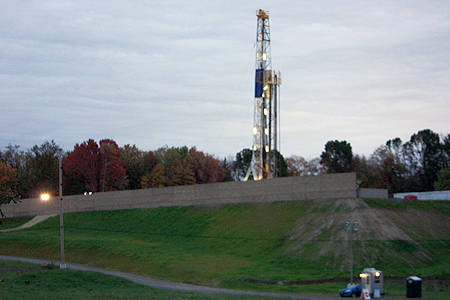Visit a Local Extension Office Looking for Shale Lease, Pipeline Information
Wednesday, June 5, 2013

PIEDMONT, Ohio — When Dick and Kaye Clay were approached by a shale energy representative about possibly leasing a portion of their Harrison County land, Kaye Clay knew where to turn for help.
She had previously worked for the Guernsey County office of Ohio State University Extension and was familiar with a fact sheet that Extension educator Clif Little had written in 2008, Leasing Farmland for Oil and Gas Production.
(The publication is available online at http://ohioline.osu.edu/als-fact/.)
Armed with information
“Knowledge is gold,” Kaye Clay said. “I thought I knew a few things about oil and gas development, but I didn’t know a fraction. That’s where Extension comes in. That’s where I turn.”
The Clays used the fact sheet’s checklists to prepare for negotiations with Gulfport Energy, and also talked with Little “and picked his brain,” she said.
“Extension educators are so willing to share their knowledge, and if they don’t know, there’s someone they can contact and get back with an answer,” she said. “I can’t say enough about Extension.”
Pipeline easement
Dave McCleary in neighboring Tuscarawas County had a similar experience.
A representative knocked on his door with a lease agreement to run a pipeline on McCleary’s land. The representative “came back the next day wondering if we had signed the agreement so he could give us our check,” McCleary said.
“It was tempting — he was standing there with that check in his hand, but if we had signed it then, I would have ended up with a small check and a big headache.”
Who can you call?
Fortunately for McCleary, he had been able to talk to Extension educator Chris Zoller at a meeting the previous night.
Zoller gave him a list of questions about issues he should check before signing into the contract.
“The company came to me with a one-and-a-half-page lease agreement that was very much in their favor,” McCleary said. “It went from that to seven pages covering everything from how deep the pipe will be buried, details about timber, brush and stump removal, and what they would re-seed the land with.
“He (Zoller) gave me lots of good information to protect me. Some of those things I would have caught, but not everything.”
Call an attorney
Zoller also advised McCleary to take the agreement to a lawyer with experience in oil and gas leasing issues before signing it.
“The attorney looked at me and said, ‘I’m glad you came,'” McCleary said. “In the end, he got me eight times the lease price the company originally offered.”
Protecting investment
McCleary had a clause written into his lease that the company would erect temporary fencing and then replace the permanent fence when the pipeline installation was completed, so he could continue to use that land as pasture for his cattle.
The Clays made sure eight spring developments that are used for both their livestock (cattle and sheep) and their home were protected.
“This drilling pad will probably be here for 25 years, and this land will be here when we’re gone,” Kaye Clay said. “We want to make sure everything is done right for our family, for the next generation.”
OSU Extension
Since 2010, OSU Extension has devoted a growing portion of its resources to work on shale energy issues.
The statewide OSU Extension Shale Energy Workgroup meets monthly to discuss emerging needs and get updates from the Ohio Farm Bureau, which also offers programs across the state, and from the Ohio Department of Natural Resources.
In addition, the group created a website, http://shalegas.osu.edu, as part of the university’s Subsurface Energy Resource Center (SERC), where Ohioans can get information about shale development, leasing, taxation issues, pipelines, water resources, community impacts and other issues related to shale development.
Joining other states
“We’ve consulted extensively with colleagues at Penn State and have signed a memorandum of understanding with West Virginia University to partner on this issue, said Bruce McPheron, dean of CFAES and Ohio State’s vice president for agricultural administration, “combining the expertise from land-grant universities to better prepare for the shale boom.”
“But there is far more need than we have human capital to conduct the necessary research and outreach to support decades of shale gas management.”
On call
Zoller said the experience has kept him busy but has been rewarding.
“It’s what we’re supposed to be doing: educating people and helping them make good decisions,” he said. “We tell people, ‘Get as much information as you can, evaluate that information, and then make the best decision possible.'”
Although it’s unclear how far west in Ohio shale development will occur, companies are already doing some legwork exploring the possibilities.
In fact, Little and fellow Extension educator Chris Penrose were invited to southern Illinois last year and spoke to about 600 people there about Ohio’s experience with shale energy development, and they’re heading back later this month.
Start reading now
For landowners who haven’t yet dealt with these decisions, Little advises them to not delay before doing their homework.
“Don’t wait to clear up any old lease issues,” he said. “Don’t wait to find out if you own your mineral rights.”




